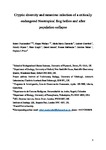Cryptic diversity and ranavirus infection of a critically endangered Neotropical frog before and after population collapse
| dc.contributor.author | Puschendorf, Robert | |
| dc.contributor.author | Wallace, M | |
| dc.contributor.author | Chavarría, MM | |
| dc.contributor.author | Crawford, A | |
| dc.contributor.author | Wynne, F | |
| dc.contributor.author | Knight, Mairi | |
| dc.contributor.author | Janzen, D | |
| dc.contributor.author | Hallwachs, D | |
| dc.contributor.author | Palmer, C | |
| dc.contributor.author | Price, S | |
| dc.date.accessioned | 2019-03-05T11:19:36Z | |
| dc.date.issued | 2019-04-16 | |
| dc.identifier.issn | 1367-9430 | |
| dc.identifier.issn | 1469-1795 | |
| dc.identifier.uri | http://hdl.handle.net/10026.1/13415 | |
| dc.description.abstract |
<jats:title>Abstract</jats:title><jats:p>Mesoamerican amphibian declines in apparently pristine and protected habitats have been severe, especially at elevations above 500 m sea level and have been linked to emerging diseases and a changing climate. The <jats:italic>Craugastor punctariolus</jats:italic> species series of direct developing frogs is endemic to the region and used to be comprised of 33 species, seven of which have known populations at present. One of these, <jats:italic>C. ranoides</jats:italic>, endemic to southern Nicaragua and Costa Rica, was historically found in cloud forest sites of Área de Conservación Guanacaste (ACG) in north‐west Costa Rica and extended into dry forest sites 20 km distant. Here, <jats:italic>C. ranoides</jats:italic> declined and disappeared from high elevation sites between the mid‐1980s and early 1990s, but populations persisted in the lowland dry forest. We compared the genetic richness and ranavirus infection status of <jats:italic>C. ranoides</jats:italic> from extant dry forest populations to historic museum specimens of now extinct ACG cloud forest populations using DNA sequence diversity at two mitochondrial loci and molecular screening for ranavirus. Extant dry forest populations of <jats:italic>C. ranoides</jats:italic> formed a monophyletic group which included historic specimens sampled at cloud forest sites. However, the extirpated ACG cloud forest population contained additional diversity: samples formed a divergent clade with unknown spatial distribution. Ranavirus was detected in both current and museum samples of <jats:italic>C. ranoides</jats:italic> and sequences from a 267‐nucleotide region of the major capsid protein gene shared 100% sequence identity with one another and with <jats:italic>Frog virus 3</jats:italic>. Our findings document cryptic diversity within an endangered species that has demonstrated no recovery in cloud forests and raises questions about <jats:italic>Ranavirus</jats:italic> and its potential link to the amphibian declines in this system. The presence of the same <jats:italic>C. ranoides</jats:italic> clade within present day and historical samples suggests a potential for effective translocation and repopulation of extirpated cloud forest populations.</jats:p> | |
| dc.format.extent | 515-524 | |
| dc.language | en | |
| dc.language.iso | en | |
| dc.publisher | Wiley | |
| dc.subject | Amphibian declines | |
| dc.subject | amphibian diseases | |
| dc.subject | ranavirosis | |
| dc.subject | Frog virus 3 | |
| dc.subject | Craugastor ranoides | |
| dc.subject | Costa Rica | |
| dc.subject | cryptic diversity | |
| dc.subject | rana virus | |
| dc.title | Cryptic diversity and ranavirus infection of a critically endangered Neotropical frog before and after population collapse | |
| dc.type | journal-article | |
| dc.type | Journal Article | |
| plymouth.author-url | https://www.webofscience.com/api/gateway?GWVersion=2&SrcApp=PARTNER_APP&SrcAuth=LinksAMR&KeyUT=WOS:000488866900011&DestLinkType=FullRecord&DestApp=ALL_WOS&UsrCustomerID=11bb513d99f797142bcfeffcc58ea008 | |
| plymouth.issue | 5 | |
| plymouth.volume | 22 | |
| plymouth.publication-status | Published | |
| plymouth.journal | Animal Conservation | |
| dc.identifier.doi | 10.1111/acv.12498 | |
| plymouth.organisational-group | /Plymouth | |
| plymouth.organisational-group | /Plymouth/Faculty of Science and Engineering | |
| plymouth.organisational-group | /Plymouth/Faculty of Science and Engineering/School of Biological and Marine Sciences | |
| plymouth.organisational-group | /Plymouth/REF 2021 Researchers by UoA | |
| plymouth.organisational-group | /Plymouth/REF 2021 Researchers by UoA/UoA06 Agriculture, Veterinary and Food Science | |
| plymouth.organisational-group | /Plymouth/Users by role | |
| plymouth.organisational-group | /Plymouth/Users by role/Academics | |
| dcterms.dateAccepted | 2019-02-22 | |
| dc.rights.embargodate | 2020-4-15 | |
| dc.identifier.eissn | 1469-1795 | |
| dc.rights.embargoperiod | Not known | |
| rioxxterms.version | Accepted Manuscript | |
| rioxxterms.versionofrecord | 10.1111/acv.12498 | |
| rioxxterms.licenseref.uri | http://www.rioxx.net/licenses/all-rights-reserved | |
| rioxxterms.licenseref.startdate | 2019-04-16 | |
| rioxxterms.type | Journal Article/Review |


